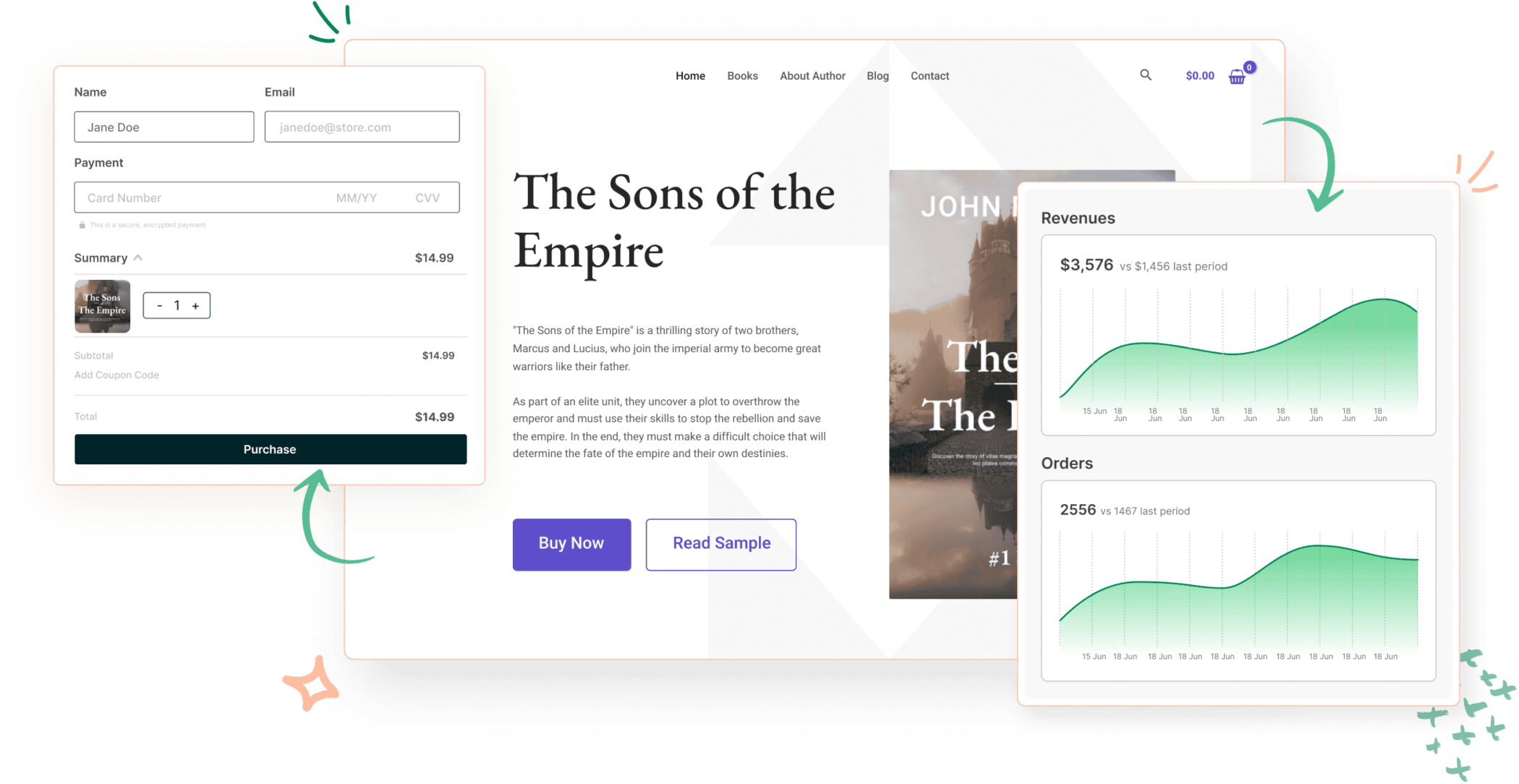The Real Cost of Running an eCommerce Store: Hidden Fees and How to Avoid Them

So, you’ve decided to launch or grow your online store — congratulations! But before you dive head-first into the world of eCommerce, it’s crucial to understand the costs involved and the key metrics you need to track. Running an online store isn’t just about setting up a website and waiting for sales to roll in; it involves many costs and metrics that can make or break your business. This guide will help you understand the essentials, from the costs you’ll encounter to the metrics you should keep a close eye on to ensure your store thrives.
1. Domain and Hosting Costs: The Essentials to Get Started
Your domain name and hosting are the foundations of your online store. A domain typically costs between $10 to $50 per year, depending on its popularity and the registrar you choose. Hosting is a more complex expense. For example, if you’re using Shopify, you’re essentially paying for hosting through their platform fees, which start at $29 per month. If you’re using WooCommerce, you’ll need to pay for web hosting separately, which could range from $3 to $50 per month or more, depending on your hosting provider and the level of service you need.
Cost-Saving Tips:
- Domain Bundles: Some hosting providers, like Bluehost, offer free domains with their hosting packages.
- Managed vs. Unmanaged Hosting: Managed WordPress hosting might seem expensive, but it can save you in the long run with included services like backups and security.
2. Platform Fees: The Hidden Cost of Your Chosen Platform
Platform fees can be a silent cost that creeps up on you. Shopify has fixed monthly fees depending on the plan, but also additional transaction fees if you don’t use Shopify Payments. WooCommerce, while a free plugin for WordPress, requires paid extensions for certain functionalities, which can add up.
Cost-Saving Tips:
- Choose the Right Plan: Start with a basic plan that fits your needs. Upgrading is always an option as your store grows.
- Use Built-In Payment Gateways: Shopify Payments or other integrated options can help you avoid extra fees.
3. Transaction Fees: The Unavoidable Percentage That Adds Up
Every time you make a sale, a percentage of your revenue is eaten up by transaction fees. For instance, Shopify charges 2.9% + 30¢ per online credit card transaction on its basic plan. WooCommerce’s fees depend on the payment gateway you use, such as PayPal or Stripe, which charge similar rates.
Cost-Saving Tips:
- Negotiate Lower Fees: High-volume sellers might be able to negotiate lower rates with payment processors.
- Offer Bank Transfers: For certain regions, offering bank transfers can save on transaction fees.
4. Development Costs: The Price of Customizing Your Store
While platforms like Shopify and WooCommerce are built to be user-friendly, you may still need to invest in development costs for customization or adding specific features. Depending on the level of customization, this could range from $500 to $5,000 or more. Don’t forget about ongoing maintenance costs to keep your site running smoothly and securely.
Cost-Saving Tips:
- DIY Learning: Learn the basics of platform management to handle minor customizations.
- Leverage Themes and Plugins: Utilize the many free and premium themes or plugins to achieve the desired look and functionality without heavy development.
5. Marketing and Advertising Costs: The Ongoing Battle for Attention
Once your store is set up, you need traffic, and that’s where marketing costs come into play. These can include Google Ads, Meta Ads, email marketing, SEO efforts, and influencer collaborations. Depending on your strategy, marketing can easily be your largest ongoing cost.
Cost-Saving Tips:
- Start Organic: Focus initially on SEO, social media marketing, and content marketing, which have lower upfront costs.
- Optimize Paid Ads: Use A/B testing to ensure you’re getting the best return on ad spend (ROAS).
6. Customization Costs: Standing Out with Unique Features
Customization involves tailoring your store’s look and functionality to align with your brand’s identity. While many platforms offer templates, making your store truly unique may require custom design and development, which can quickly become costly.
Cost-Saving Tips:
- Use What’s Available: Before opting for custom solutions, exhaust the built-in options available on your platform.
- Free and Affordable Plugins: Both Shopify and WooCommerce have vast libraries of plugins and apps that can add functionality without breaking the bank.
7. Payment Gateway Charges: The Hidden Price of Getting Paid
Apart from transaction fees, there are also fees specific to payment gateways like PayPal or Stripe, which charge for each transaction processed. These fees can vary by country and payment method.
Cost-Saving Tips:
- Select Cost-Effective Gateways: Choose payment gateways that offer the best rates for your most popular regions.
- Consider Local Gateways: If you’re selling primarily in a specific country, look for local payment solutions that offer lower fees.
8. Shipping and Fulfillment Costs: Beyond Just Moving Products
Shipping costs can be a major expense, especially if you’re offering free shipping to customers. This includes packaging materials, shipping insurance, carrier fees, and even storage fees if you’re using a third-party fulfillment service.
Cost-Saving Tips:
- Negotiate Shipping Rates: Partner with carriers like UPS, FedEx, or DHL to get discounted rates, especially if you ship in bulk.
- Offer Free Shipping Strategically: Consider offering free shipping above a certain order value to encourage larger purchases.
9. RTO (Return to Origin) Costs: When Things Go Wrong
RTO costs occur when products are returned to the origin due to failed delivery attempts. This is particularly common with Cash on Delivery (COD) orders in regions like India. RTO costs can include return shipping fees, restocking fees, and even lost sales.
Cost-Saving Tips:
- Communicate Clearly: Send delivery notifications via SMS or email to minimize failed deliveries.
- Improve Descriptions: Make sure your product descriptions are accurate and comprehensive to reduce returns.
10. Email or WhatsApp Integrations: Staying in Touch with Customers
Customer engagement tools like email and WhatsApp integrations are essential for marketing and customer support but come with their own costs. While some tools are free up to a certain limit, others charge based on the number of subscribers or messages sent.
Cost-Saving Tips:
- Use Free Plans: Start with free tools like Mailchimp or WhatsApp Business and upgrade as needed.
- Automate Smartly: Focus on essential workflows like abandoned cart reminders to maximize impact.
11. Site Security and Maintenance: Protecting Your Business
Keeping your site secure and well-maintained is crucial. This includes SSL certificates, security plugins, and regular backups. Neglecting these can lead to data breaches, downtime, and lost revenue.
Cost-Saving Tips:
- Opt for Free SSL: Use free SSL certificates from providers like Let’s Encrypt.
- Choose Secure Hosting: Invest in secure hosting that includes regular backups and security monitoring.
12. Support and Training: Empowering Your Team
If you’re not tech-savvy or don’t have a team in place, you may need ongoing support or training for your platform. This could range from hiring a consultant to purchasing online courses or paying for premium support from your platform provider.
Cost-Saving Tips:
- Leverage Free Resources: Many platforms offer free tutorials, webinars, and community forums.
- Invest in Basic Training: Consider investing in foundational training for your team to reduce long-term dependency on external help.
Final Thoughts: Navigating the Real Costs of eCommerce
Understanding the real costs involved in running an eCommerce store is crucial for long-term success. By being aware of these hidden fees and knowing how to minimize them, you can keep your business running smoothly and profitably.
Need Help Cutting Down Your eCommerce Costs? At Nade XP, we specialize in optimizing eCommerce businesses for growth while minimizing expenses. Let’s work together to build a more profitable and scalable online store for you. Contact us today to get started!
FAQs
Shopify offers built-in features for abandoned cart recovery emails. You can automate emails to be sent to customers who leave items in their cart. Go to “Settings” > “Checkout” and configure your preferences for abandoned cart recovery emails.
No, you don’t need coding knowledge to start an eCommerce store. Platforms like Shopify and WooCommerce offer user-friendly interfaces that allow you to set up and customize your store without any coding skills. You can choose themes, customize your store’s appearance, and add products with ease. For more advanced customization, you can hire a developer, but most users find the built-in tools sufficient to run their online business.
SureCart is ideal for businesses selling digital goods, subscriptions, or services like consultations. It’s a great fit for small businesses, digital content creators, and service-based businesses. However, if you are a larger business needing advanced features, like POS systems, extensive payment gateway options, and multicurrency support, other platforms like Shopify or WooCommerce might be a better choice.
SureCart’s primary limitations include its limited selection of payment gateways and lack of POS system integration. Additionally, multicurrency support is not yet available, which could be an issue for international sellers. While the platform is great for getting started, more advanced eCommerce stores might find the lack of features like bulk editing for physical products and limited marketing integrations to be restrictive.
Yes, SureCart is an excellent option for digital products and services. It offers flexibility with various pricing models, such as subscriptions, pay-what-you-want options, trial period purchases, and installment plans. If you’re selling digital goods like courses, consultations, or downloadable content, SureCart provides a seamless checkout process and saves on recurring fees like those charged by Stripe.
RTO costs refer to the expenses incurred when a product is returned by the customer to the seller. They can be reduced by offering accurate product descriptions, clear sizing charts, and high-quality images to minimize returns. Also, consider using automated tools to verify phone and addresses to avoid delivery failures.
Focus on organic traffic by investing in SEO, content marketing, and social media strategies. Leverage free tools and platforms for email marketing, create a referral program, and collaborate with influencers who align with your brand to drive traffic at a lower cost.
Shopify charges a monthly fee and transaction fees, while WooCommerce is free but requires hosting, domain, and additional plugin expenses. SureCart runs on WordPress and charges based on subscription plans with additional fees for higher volume or advanced features. Each platform’s cost will vary depending on store size, sales volume, and specific needs.
To reduce payment gateway charges, compare different providers to find one with the lowest fees for your sales volume and preferred payment methods. Also, consider offering multiple payment options to reduce dependency on a single gateway and potentially negotiate better rates based on your transaction volume.
Yes, several costs can catch store owners off guard, such as transaction fees for payment processing, additional fees for custom plugins or themes, charges for email or SMS marketing integrations, shipping costs (including international), and expenses related to returns or refunds.
The primary costs include domain registration, platform fees (like Shopify or WooCommerce), hosting fees, payment gateway charges, and marketing expenses. Additionally, you should account for costs like website development, customization, shipping, returns (RTO), online store maintenance, and site security.
WooCommerce allows you to customize the checkout process extensively. You can simplify fields, remove unnecessary steps, and optimize for mobile. Plugins like “Checkout Field Editor” let you customize the checkout form to suit your needs.
Some popular plugins include CartFlows for optimizing the checkout process, YITH WooCommerce Recover Abandoned Cart for email recovery, and TrustPulse to build social proof. These tools help in reducing abandonment rates by enhancing the user experience.
WooCommerce does not have built-in abandoned cart recovery features, but you can use plugins like WooCommerce Cart Abandonment Recovery or Retainful. These plugins help you create automated emails and track abandoned carts to re-engage customers.
Shopify’s checkout is already streamlined, but you can further optimize it by offering guest checkout, reducing the number of steps, and ensuring your store is mobile-friendly. Consider using Shopify’s “Shop Pay” for a faster, one-click checkout experience.
There are several apps on Shopify that can help, such as Privy, Klaviyo, and ReConvert. These apps offer features like exit-intent pop-ups, retargeting, and automated email or SMS campaigns to re-engage potential customers.
SureCart is a WordPress plugin designed for digital products and subscriptions, offering features like subscription billing automation and license key management. WooCommerce is a versatile, open-source plugin also for WordPress, ideal for physical products with a wide range of plugins but requires more setup. Shopify is an all-in-one platform with robust marketing integrations and ease of use but comes with higher fees and limited customization compared to WordPress-based solutions.
Yes, offering discounts or incentives like free shipping can help recover abandoned carts. However, this should be done carefully to avoid training customers to abandon carts deliberately to receive discounts. Consider personalized offers based on the customer’s behavior or cart value.
Important KPIs include cart abandonment rate, recovery rate, conversion rate after recovery efforts, click-through rate (CTR) on abandoned cart emails or messages, and average order value (AOV) from recovered carts. Regularly tracking these KPIs will help you gauge the effectiveness of your strategies.
WhatsApp and SMS can be powerful tools for recovering abandoned carts, especially in regions where these platforms are widely used, like India. These methods offer a direct line to customers, allowing personalized communication, answering questions, and even providing exclusive discounts to encourage a return to the cart.
Some effective strategies include simplifying the checkout process, being transparent about all costs (including shipping), offering multiple payment options, optimizing your website for mobile devices, and using retargeting techniques like abandoned cart emails and SMS messages.
Use tools like Google Analytics to analyze user behavior and identify drop-off points in your checkout process. Heatmaps, customer surveys, and exit-intent pop-ups can also provide insights into why customers are not completing their purchases.
The average cart abandonment rate across all industries is around 60-70%. However, what is considered “good” depends on your industry. If your rate is higher than this average, it could indicate areas for improvement in the shopping experience.
There are several reasons for cart abandonment, including unexpected shipping costs, complicated checkout processes, lack of trust or security, slow website performance, and limited payment options. Understanding these reasons helps in creating strategies to reduce abandonment rates.
Cart abandonment occurs when a potential customer adds items to their online shopping cart but leaves the website without completing the purchase. It’s a critical metric for eCommerce businesses as it directly affects sales and revenue.
If you have a limited budget and are familiar with WordPress, WooCommerce may be the best option due to its free core and the availability of cost-effective plugins. SureCart’s free plan is also a good choice for digital products, but keep in mind the transaction fee. Shopify is more expensive, but it offers a lot of built-in features that might save you time and effort in the long run.
SureCart’s free plan limits you to 50 abandoned cart recoveries per month, 1 order bump, and 1 one-click upsell. Additionally, there is a 1.9% transaction fee on the free plan, which may add up depending on your sales volume.
Yes, SureCart is particularly well-suited for digital products and software. It offers license key management, validation, and activation API, making it ideal for software distribution. Additionally, SureCart supports automated billing for subscriptions and other recurring payments.
WooCommerce and Shopify are both strong contenders for selling physical products. WooCommerce offers more customization and is cost-effective if you are familiar with WordPress. Shopify excels in ease of use, integrated shipping, and POS support, making it a good choice for those looking for a turnkey solution.
Yes, since SureCart runs on WordPress, you will need a reliable hosting provider. However, SureCart manages eCommerce-related processes on its servers, reducing the load on your WordPress site, so you won’t need to worry about performance issues typical of eCommerce-heavy sites.
SureCart’s free plan includes essential features but charges a 1.9% transaction fee and has limits on abandoned cart recoveries and upsells. Paid plans start at $19/month. WooCommerce is free to start but requires paid plugins and hosting. Shopify offers a straightforward pricing model starting at $29/month, but with additional transaction fees unless using Shopify Payments.
SureCart is an excellent choice if you are selling digital products, memberships, or subscriptions, thanks to its automation features and ease of use. However, it’s fairly new compared to WooCommerce and Shopify, so if you need extensive marketing integrations or POS support, you might consider Shopify or WooCommerce.















